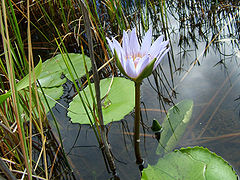Nymphaea capensis
| Nymphaea capensis subsp. var. | Cape blue waterlily | |||||||||||||||||||||||||||||||||||||||||||||||||||||||
|---|---|---|---|---|---|---|---|---|---|---|---|---|---|---|---|---|---|---|---|---|---|---|---|---|---|---|---|---|---|---|---|---|---|---|---|---|---|---|---|---|---|---|---|---|---|---|---|---|---|---|---|---|---|---|---|---|

|
|
| ||||||||||||||||||||||||||||||||||||||||||||||||||||||
| ||||||||||||||||||||||||||||||||||||||||||||||||||||||||
The Cape blue water lily (Nymphaea capensis Thunb.) is an aquatic flowering plant of the family Nymphaeaceae.
It is found growing abundantly in freshwater habitats in South Africa and neighbouring countries.
This plant's bulb can survive relatively long periods of time without rainfall in a dry river bed. During the rain season, as the riverbed or bog fills up, the bulb will sprout leaves and flowers.
The Cape blue water lily grows best in full sun to semi-sun and in relatively shallow water.
| Standard Cyclopedia of Horticulture |
|---|
|
Nymphaea capensis, Thunb. (N. scutifolia, DC.). Cape Blue Water-lily. Lvs. rather narrowly peltate, orbicular-ovate, strongly sinuate- dentate; angle of lobes produced, acuminate; 12—16 in. across: fls. rich sky-blue, 6-8 in. across; open 4 days from 7 A.M. to 4 P.M.; buds ovate; sepals pure green outside, whitish within; petals 20-30, lower third nearly white, narrowly elliptic; stamens about 150; filaments yellow, outermost ones broad, innermost filiform; appendage and back of outer anthers blue. S. Afr.—A very desirable species.
|
Cultivation
Propagation
Pests and diseases
Varieties
Gallery
References
- Standard Cyclopedia of Horticulture, by L. H. Bailey, MacMillan Co., 1963
External links
- w:Nymphaea capensis. Some of the material on this page may be from Wikipedia, under the Creative Commons license.
- Nymphaea capensis QR Code (Size 50, 100, 200, 500)
